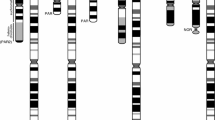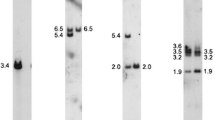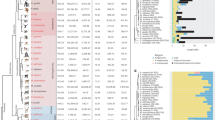Abstract
Every species of non-human primates, especially those of hominoids, has a variety of reproductive structures and accompanying male traits, such as sexual dimorphism and relative size of testis to body weight, which may be at least partly triggered by DNA on the Y-chromosome. Recently, a panel of PCR (Polymerase Chain Reaction) primer sets were designed to amplify various DNA segments spread over the human Y-chromosome. We applied these primer sets for amplification of DNA segments on the Y-chromosome of hominoid species: chimpanzee, bonobo (Pygmy chimpanzee), gorilla, orangutan, whitehanded gibbon, agile gibbon, and Japanese monkey as an out group. The DNA segments including SRY, testis determining factor, and ZFX/ZFY could be amplified clearly in males of all species examined. These highly conserved genes may serve important biological functions. However, as the phylogenic distance from humans increased, some of the DNA segments could not be amplified. For example, DYZ1 (SY160) could be amplified only using human DNA as a template, and DYF60S1 (SY61), DYZ217 (SY126) and DYS233 (SY148) could be amplified only using human and African great ape DNA. It is interesting to note that locus DYS250 (SY17) could not be amplified in chimpanzee and bonobo but amplified in gorilla and orangutan. Locus DYS251 (SY18) was amplified in all species except the white-handed gibbon. These results indicate that a variety of evolutionary events including mutation, deletion, insertion, and rearrangement occurred in Y-chromosome DNA during primate evolution.
Similar content being viewed by others
References
Delson E., Eldredge N., & Tattersall I., 1977.Reconstruction of hominid phylogeny: a testable framework based on cladistic analysis. Journal of Human Evolution 6: 263–278.
Fisher E. M. C., Beer-Romero P., Brown L. G., Ridley A., McNeil T. A., Lawrence J. B., Willard H. F., Bieber, F. R. & Page D. C., 1990.Homologous ribosomal proteins on the human X and Y chromosomes: Escape from X inactivation and possible implications for Turner syndrome. Cell, 63: 1205–1218
Garza, J. C. & Woodruff D. S., 1992.A phylogenetic study of the gibbons (Hylobates) using DNA obtained nonvasively from hair. Molecular Phylogenetics and Evolution, 1: 202–210.
Gonzales I. L., Sylvester J. E., Smith T. F., Stambolian D. & Schmickel, R. D., 1990Ribosomal RNA gene sequences and hominoid phylogeny. Molecular Biology and Evolution, 7(3): 203–219.
Haimoff E. H., Chivers D. J., Gittins S. P. & Whitten T., 1982.A phylogeny of gibbons based on morphological and behavioral characters. Folia Primatologica, 39: 213–237.
Horai S., Satta Y., Hayasaka K., Kondo, R., Inoue T., Ishida T., Hayashi S. & Takahata N., 1992.Man’s place in hominoidea revealed by mitochondria DNA genealogy. Journal of Molecular Evolution, 35: 32–43.
Koop B. F., Goodman M., Xu P., Chan K. & Slightom J. L., 1986.Primate globin DNA sequences and man’s place among the great apes. Nature, 319(16): 234–237.
Koopman P., Gubbay J., Collignon J. & Badge-Lovell R., 1989.Zfy gene expression patterns are not compatible with a primary role in mouse sex determination. Nature, 342: 940–942.
Lundrigan B. L. & Tucker P. K., 1994.Tracing paternal ancestry in mice, using the Y-linked sex-determining locus, Sry. Molecular Biology and Evolution 11(3): 483–493.
Maniatis T., Fritsch E. F. & Sambrook J., 1989.Molecular cloning: A laboratory manual. Cold Spring Harbor Laboratory, New York.
Mardon G., Mosher R., Disteche C. M., Nishioka Y., Mclaren A. & Page, D. C., 1989.Duplication, deletion, and polymorphism in the ses-determining region of the mouse Y chromosome. Science, 243: 78–80.
Miller D. A., 1977.Evolution of primate chromosomes. Science, 198: 1116–1124.
Müller G. & Schempp W., 1991.Comparative mapping of ZFY in the hominoid apes. Human Genetics, 88: 59–63.
Nagamine C. M., Chan K., Kozak C. A. & Lau Y. F., 1989.Chromosome mapping and expression of a putative testis-determining germ in mouse. Science, 243: 80–83.
Ohno S., 1967.Sex chromosome and sex-linked gene. Springer-Verlag, New York.
Page D. C., Mosher R., Simpson E. M., Fisher E. M. C., Mardon G., Pollack J., McGillivray B., de la Chapelle A. & Brown L. G., 1987.The sex-determining region of the human Y chromosome encodes a finger protein. Cell, 51: 1091–1104.
Shimmler M. C., Rouyer F., Vergnaud G., Nystron-Lahti M., Ngo K. Y., de la Chapelle A. & Weissenbach J. (1985)Pseudoautosomal DNA sequence in the pairing region of the human sex chromosomes. Nature, 317: 692–697.
Short R. V. 1979. Sexual selection and its component parts, somatic and genital selection, as illustrated by man and great apes. In (J. S. Rosenblatt, R. A. Hinde, C. Beer and, M.-C. Busnel, eds.). Advances in the Study of Behavior, pp. 131–158. Academic Press Ltd.
Sibley C. G. & Ahlquist J. E., 1987.DNA hybridization evidence of hominoid phylogeny: results from an expanded data set. Journal of Molecular Evolution, 26: 99–121.
Sinclair A. H., Berta P., Palmer M. S., Hawkins J. R., Griffith B. L., Smith M. J., Foster J. W., Frischauf A. M., Lovell-Badge R. & Goodfellow P. M., 1990.A gene from the human sex-determining region encodes a protein with homology to a conserved DNA-binding motif. Nature, 346: 240–244.
Tegelström O. H., 1986.Mitochondrial DNA in natural populations: an improved routine for the screening of genetic variation based on sensitive silver staining. Electrophoresis, 7: 226–229.
Tierch T. R., Mitchell M. J. & Wachtel S. S., 1991.Studies on the phylogenetic conservation of the SRY gene. Human Genetics, 87: 571–573.
Toder R., Zeitler S., Goodfellow P. N. & Schempp W. 1993Comparative mapping of SRY in the great apes. Chromosome Research, 1: 117–120.
Ueda S., Takenaka O. & Honjo T., 1985.A truncated immunoglobulin E pseudogene is found in gorilla and man but not in chimpanzee. Proceedings of the National Academyl of Sciences of the United States of America, 82: 3712–3715.
Vollrath D., Foote S., Hilton A., Brown L. G., Beer-Romero P., Bogan J. S. & Page D. C., 1992.The human Y chromosome: A 43-interval map based on naturally occurring deletions. Science, 258 (2): 52–59.
Weber B., Schempp W. & Wiesner H., 1986.An evolutionarily conserved replicating segment on the sex chromosomes of man and great apes. Cytogenetics Cell Genetics, 43: 72–78.
Wrangham R. W. 1987. Evolution of social structure. In (B. Smuts, R. Seyfarth, R. Wrangham and T. Struhsaker, eds.). Primate Societies, pp. 282–296. The University of Chicago Press.
Author information
Authors and Affiliations
Rights and permissions
About this article
Cite this article
Kim, HS., Takenaka, O. Evolution of DNA on Y-chromosome in hominoid primates as examined by PCR. Hum. Evol. 12, 233–239 (1997). https://doi.org/10.1007/BF02438177
Issue Date:
DOI: https://doi.org/10.1007/BF02438177




